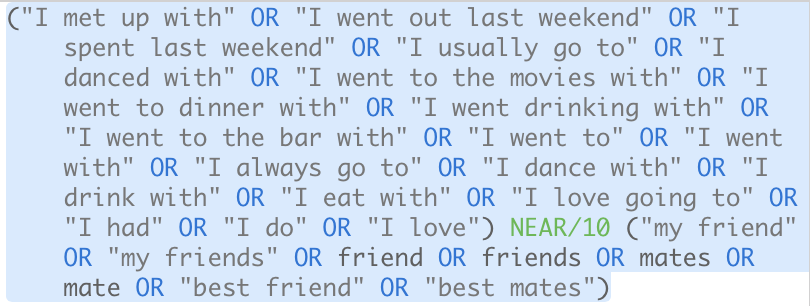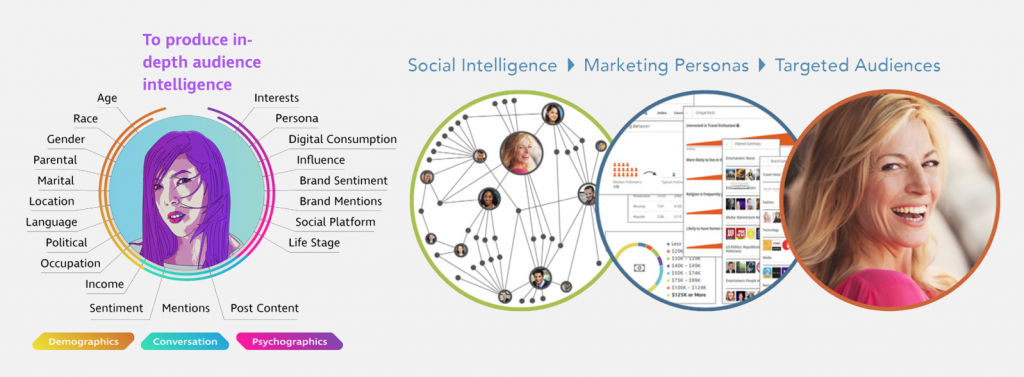SUMMARY: The formula for best-practice audience intelligence work is dynamic, due to rapidly advancing technologies and practices. We also have to take into consideration federal and nation-state regulations which are constantly in flux. As of December 2017, this is a formula for producing a fully enriched audience based on the beginning point of email, social handle, or a conversation snippet from social media, blogs, forums or comment threads on news sites. I might add that the acceleration of AI (Artificial Intelligence) and ML (Machine Learning) is rapidly condensing the steps below. APIs (Application Programming Interface) are being woven together to produce highly sophisticated machinery that blends outputs from various data sources.
THE FORMULA (LATE DECEMBER 2017):
STEP 1: Interview the client to determine goals and deliverables. This is important because we want to understand the client’s business and his specific goals related to the research. This is the time to see eye-to-eye with the client and really get to know his/her business from the inside-out.
STEP 2: Perform tests using the software below to discover opportunities related to the client’s desires/needs. Most social monitoring/aud intel solutions provide a way to quickly preview “the universe” related to a specific research request. This step is important as part of putting together the proposal for the client.
STEP 3: Design the audience intelligence study. Gain approval from the client, sign contracts, receive funding from the client. This is important because the client will want to look over the exact type of deliverable he/she will be receiving, as well as hearing a bit about your approach in putting together the final “data lake” of prospects and, of course, how the insights will be presented.
STEP 4: HOW DO PEOPLE DESCRIBE THEMSELVES IN SOCIAL BIOS: We gather a set of social handles where our keywords are in the bio. This from Audiense.com, Affinio, Brandwatch and PeoplePattern primarily, but can also be from using Data-Miner.io in LinkedIn, along with many other sources herein un-named. This is important because self-description by individuals is rather verbose these days..and this is helpful to us in finding our targets. And, where self-description is not verbose, there are clues through company/press/3rd-party descriptions of specific individuals who work for/play at/eat at/drink at/shop at/you-name-it at the locations/venues/places we are studying.
STEP 5: WHAT DO PEOPLE TALK ABOUT IN SOCIAL MEDIA/BLOGS/FORUMS: We gather a set of conversation snippets related to our keywords from Brandwatch, Sysomos, Crimson Hexagon and/or Meltwater. This is important because what someone says about an activity/product/service/location/you-name-it contributes towards our understanding of the consumer/customer/competitor’s consumer/customer. In addition, these conversation snippets from social media, forums, blogs, comment threads on news sites form a body of data that we can segment into specific topic groups. These specific topic groups can then be used to form a point of view/set of insights on the target we are studying.
STEP 6: SEGMENTING STEP BY MACHINE – TOPIC MODELING APPLIED TO BIOS & CONVERSATION SNIPPETS: We use Converseon’s Conversus tool to perform topic modeling and separate bios and conversation snippets into discreet topics. This is important because this speeds up the analysis of the bios and separates out the bios that matter to us the most. No solution in the world is more accurate and complete in segmenting bios and conversation snippets into discrete topic groups than Converseon’s Conversus. This solution is pure magic and the analysts at Converseon who are using Conversus are second-to-none in their expertise at building out superior insights based upon the use of their in-house solution. It is during this stage where an analyst begins to really gain deep insight into a sets of bios and sets of conversation snippets.
STEP 7: SEGMENTING STEP BY ANALYST: Now, these analysts wade into the output from Converseon’s Conversus and identify the Topic where our targets are present (and any other discovered target – unknown unknowns). This vital step by humans helps us know which Topic groups in Conversus are populated by our target. This is important work that can be recursive, whereby the analyst segments the data using Conversus, reads through the results, and then segments again to refine even more deeply. I might add that this particular step is where the machine will eventually outstrip the analyst. That outstripping of the analyst will take some time to come along, though. For now, on this step, the human continues to be the last mile.
STEP 8: RE-STITCHING AFTER SEGMENTING STEPS: Reunify the bios from the “right” Topics in Conversus with the handles in the original source data sheet. This is important because we want to have the correct bio next the correct social handle. We also stitch handles and bios next to discovered conversation snippets at this stage. We find that working in Jupyter notebooks using Python is one of the handiest ways for our teams to work together efficiently on this step.
STEP 9: PEOLE PATTERN AUDIENCE INSIGHTS STEP: Upload Twitter AND/OR Instagram handles into PeoplePattern for deeper enrichment of Interests, Location, Age, Persona. This is important because we find out more about each person and we also delineate between Individuals and Organizations. In addition, we move a step closer through PeoplePattern to verifying the “real people”. Finally, we gain insight into the Persona types, Interest groups and lots of other useful info.
STEP 10: FULL CONTACT STEP: Use the Full Contact API to append add’l social handles. The value in this particular step is discovering a full name related to the handle AND additional social handles. We also gain bios from various social media handles, thus bulking out our story about an individual.
STEP 11: PIPL STEP: We use the PIPL API to gather Email, Phone, Address, other social handles, age, and many other bits of info on individuals. This is important because we will gain additional important information about the individuals that verifies they are “real people”.
STEP 12: CRYSTAL STEP: We use the Crystal Knows API to enrich the profiles with DISC personality type, personality overview, messaging guidance, selling guidance. This is important because then we are guiding our client on how best to market, advertise and sell to this individual. We can then group individuals by DISC type, if desired.
STEP 13: CLEAN UP ROWS FOR COMPLETION: Stitch together the results from the various APIs and then filter for complete rows. Again, we use Jupyter notebooks and Python for this work, as the teamwork and efficiency is vastly improved. This stage is important because we want every row to have every cell filled with correct & complete data.
STEP 14: EXACT DATA STEP: If we want to add an extra step for verification at this point, we run the Exact Data enrichment on the emails/names discovered. This is important because this extra step adds validity to the claim that our audience is full of “real people”.
STEP 15: SPOTRIGHT STEP: Upload the social handles into Spotright to gain enrichment of offline Axciom data, such as buying/purchasing styles, net worth, income level, political/religious affiliations, housing info, household complexion info, brand preferences of a specific group uploaded and much much more.
STEP 16: INSIGHTS, METHODOLOGIES & RECOMMENDATIONS PDF: Create 3-5 page Summary PDF with insights related to the research. This is important because brand leadership will now have a set of insights about the discovered individuals (our initial data lake of prospects) and, importantly, we can recommend further research steps for successive work together.





